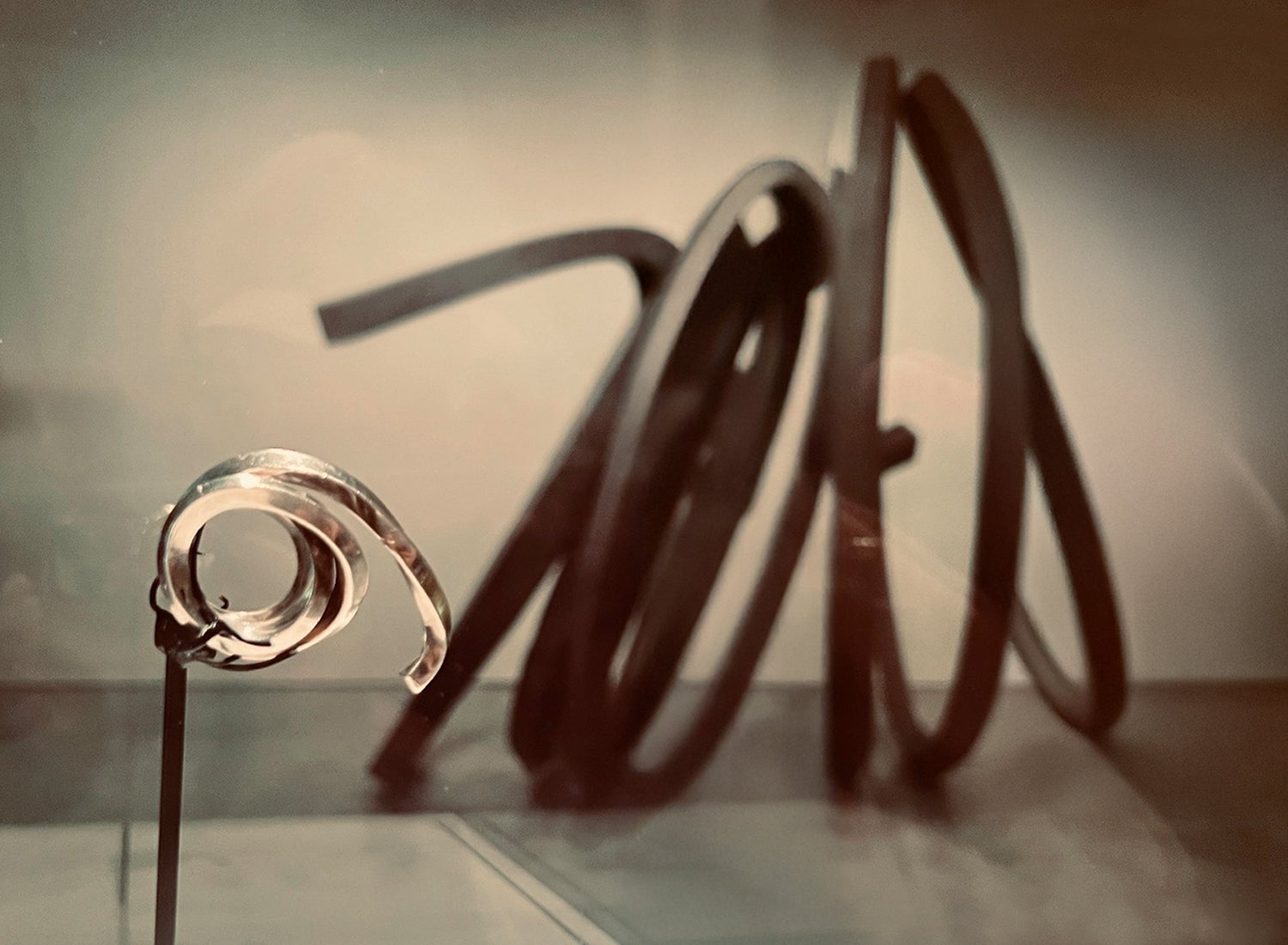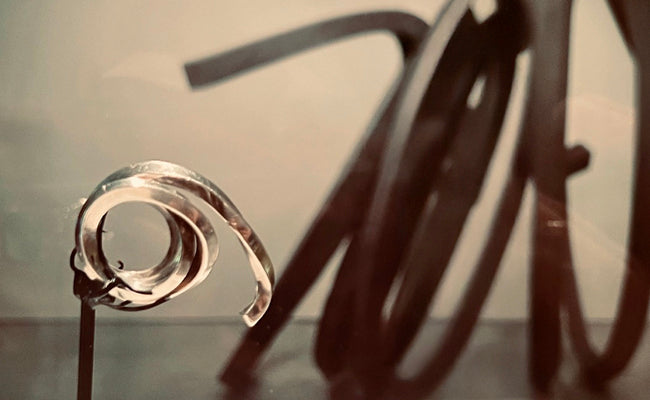Article: Art in Miniature: When Famous Artists Turned to Jewelry

Art in Miniature: When Famous Artists Turned to Jewelry
We know them for their canvases, their sculptures, and their sweeping contributions to 20th-century art. But what happens when the world’s most iconic artists turn their gaze to something small enough to wear?
That’s the magic behind Artistic Jewelry from the Diane Venet Collection, now on view at the Norton Museum of Art in Palm Beach. It's a treasure trove not of traditional jewelers, but of some of the most celebrated names in modern and contemporary art: Dalí, Lichtenstein, Picasso, Nevelson—they’re all here, and they all made jewelry.


At the entrance to the exhibit stands the piece that started it all: a sterling silver coiled ring, created by sculptor Bernar Venet for his wife, Diane Venet, in 1985. This small gesture of love sparked a collection spanning over 30 years that now includes works reaching back even earlier.

LEFT FOREGROUND: BERNAR VENET "LIGNE INDETERMINEE" (RING) SILVER; 1985; WITH ORIGINAL LARGE-SCALE MUSE BEHIND. RIGHT: SALVADORE DALI "MONTRE PETITE CUILLERE" (HAIR BROOCH) GOLD AND NIGHT BLUE ENAMEL; 1957. PHOTOS: ©ALLOYALIST
The exhibit loosely follows the narrative of art history, organizing pieces under movements like Surrealism and Pop Art, while also grouping them thematically into categories like "Nature and the Body." It’s a broad theme, and many of the pieces could easily fit within it.
One of the details I appreciated most was how often the exhibit placed an artist’s jewelry alongside one of their better-known works. Some pieces felt like straightforward miniatures—shrinking the original into wearable size. Others captured not just the shape or colors, but the spirit and energy of their larger works. This quiet dialogue between art and ornament made the jewelry feel like a natural extension of the artist’s world.

TOP: NIKI DE SAINT PHALLE "NANA ANGE" (SCUPTURE AND MATCHING BROOCH) 18K GOLD, ENAMEL, DIAMONDS; 1991. PHOTOS: ©ALLOYALIST
Diane Venet writes:
"A piece of 'artist’s jewelry,' like a painting or a piece of sculpture, is a work of art. Springing from the same creative approach, it possesses the same force, poetry and ability to provoke, sometimes even the same humor. It is only their ultimate purpose that distinguishes one from the other."
The artists whose pieces resonated most with me seemed to understand that shift. Not simply by shrinking their ideas to a smaller size, but by reimagining them through the intimacy, movement, and connection that jewelry invites. As I moved through the exhibit, I was reminded why objects (especially worn ones) move me differently than canvases on a wall.
Jewelry is lived with.
A painting stays safely on a wall. A ring or a necklace is something else entirely—handled, touched, and absorbed into daily life. Even under glass, the Yayoi Kusama necklace on display seems to hum with memory. You can almost feel its past life, worn close to someone’s skin. There’s a certain irony in seeing it isolated behind museum barriers now—an object once meant to be loved and lived with, frozen for observation. Some of the most meaningful pieces were never made to be distant at all. I wonder if this Kusama necklace was one of them.
 YAYOI KUSAMA "UNTITLED" (NECKLACE) WOOL; CIRCA 1962. PHOTOS: ©ALLOYALIST
YAYOI KUSAMA "UNTITLED" (NECKLACE) WOOL; CIRCA 1962. PHOTOS: ©ALLOYALIST
Objects blur the line between art and life.
Jewelry doesn’t just catch the eye. It becomes part of everyday living. Artists like Frank Stella once aimed to erase any sign of the hand from his work, creating pieces that felt distant and precise. But when Stella’s crisp geometry becomes a ring, or when Anish Kapoor’s mirrored forms are reimagined as rings, the effect changes. Worn close to the body, these once-detached ideas take on warmth, movement, and personal meaning. Abstraction softens. The art doesn’t just sit apart from you or reflect your image—it becomes part of you.

LEFT: FRANK STELLA "UNTITLED" (RING) GOLD; 2010. RIGHT: ANISH KAPOOR "TWO-SIDED RING" (RING) GOLD AND SILVER; 2005. PHOTOS: ©ALLOYALIST
Wearable art is inherently intimate.
Jewelry is intimate by nature. It touches the body, picks up scent, memory, and stories along the way. Man Ray’s work offers a perfect metaphor: the stark sensuality of his portrait of Kiki de Montparnasse finds a quiet echo decades later in the flowing lines of his gold pendant. Seen side by side, you can almost feel the conversation between body and object; divinity and deity. Even something as traditional as a cross, when shaped with fluidity and gesture, moves beyond a religious symbol. It becomes a deeply personal keepsake, worn and alive with meaning.

LEFT: MAN RAY "ALICE PRIN - KIKI DE MONTPARNASSE" GELATIN PRINT; 1924. RIGHT: MAN RAY "HOMMAGE" (PENDANT) GOLD; 1973. PHOTOS: ©ALLOYALIST
A shift in scale transforms the experience.
When larger-than-life artists rework their visions into something small enough to wear, the experience of their art changes too. Alexander Calder’s vast sculptures move with the wind; his jewelry moves with the body. That shift from commanding public space to becoming part of private, everyday motion, redefines how you connect to the work. Jewelry changes not just in size, but in spirit. It turns ideas meant to be admired from a distance into pieces meant to be lived with, moved with, and remembered through touch.

FROM LEFT: ALEXANDER CALDER "SPIRALES" TAPESTRY; 1975. "SPIRALES" PRINT, CIRCA 1970. UNTITLED (BROOCH) WHITE METAL; CIRCA 1950. UNTITLED (PENDANT/BELT BUCKLE) BRONZE WITH GOLD LEAF; CIRCA 1940. PHOTOS: ©ALLOYALIST
Jewelry preserves sentiment and memory.
Adornments don't just mark time. They capture it. Jean-Luc Moulène’s body impression pendant is a literal example. It’s not just about form; it holds a real moment: two bodies touching, a fleeting connection pressed into metal and made permanent. Pablo Reynoso’s gilded bronze bracelet, shown in the International Contemporary Scene section, unspools like a ribbon with no end. It feels like time itself, with milestones, memories, and little moments all looping back around. Jewelry carries these pieces of us. It becomes a living story... one that keeps unfolding long after the first chapter ends.
 LEFT: JEAN-LUC MOULENE "US TWO" BODY IMPRESSION IN METAL (PENDANT) 24K PLATED STERLING; 2023. RIGHT: PABLO REYNOSO "ARO DE HULA" (BRACELET) GILDED BRONZE; 2017. PHOTOS: ©ALLOYALIST
LEFT: JEAN-LUC MOULENE "US TWO" BODY IMPRESSION IN METAL (PENDANT) 24K PLATED STERLING; 2023. RIGHT: PABLO REYNOSO "ARO DE HULA" (BRACELET) GILDED BRONZE; 2017. PHOTOS: ©ALLOYALIST
Interestingly, the collection’s book title, From Picasso to Koons, highlights two of the more famous names—though, for me, their pieces were among the least compelling. Their inclusion makes sense from a marketing standpoint, but the works that truly stayed with me were the quieter, more surprising ones tucked between the headlines.
BOTTOM FROM LEFT: JEFF KOONS "RABBIT" (NECKLACE) PLATINUM; CIRCA 2005. PABLO PICASSO "LE GRAND FAUNE" (PANDANT) 23K GOLD; 1973. PHOTOS: ©ALLOYALIST
The collection as a whole felt like stepping into a modern royal’s private jewelry box—a world where treasures by some of the biggest names in art were, for a time, tucked quietly away. I’ve always loved seeing what people choose to gather around themselves, and this glimpse into Diane Venet’s world felt like a rare privilege.
Seeing these smaller pieces next to the artists’ larger works offered something different. Not a lesson in art history or its movements, but a glimpse into how big ideas adapt when they’re made personal. I was drawn to how each artist reshaped their vision to fit this more intimate, wearable form. I loved seeing how their ideas shifted, stretched, or found new life when designed to move with a human body instead of hanging on a wall.
I would have loved to see the exhibit dive even deeper into those shifts, or to hear more about Diane Venet’s personal relationships with the artists and the stories behind each piece. Those details would have made an already extraordinary collection feel even more intimate.
When To Go and How to Get There
-
Address: The Norton Museum of Art - 1450 S Dixie Highway, West Palm Beach, FL 33401
-
Parking: On-site, $6. Arrive before 5 PM on Fridays for easier parking.
-
Admission: $18 adults, $15 seniors, free for children under 12. Discounts for students, Florida educators, and active military.
-
Friday Evenings: Visit for Art After Dark: live music, tours, and a lively atmosphere. Museum stays open until 10pm and admission is only $10 if reserved online in advance.
-
Best Times to Visit:
• Friday evenings for energy and events (arrive early!)
• Weekday mornings for a quieter experience. -
Dining: The Norton’s café serves up more than great food. It offers garden views from the museum’s historic wing and terrace seating so photogenic, you might feel like the star of your own Slim Aarons photo.
-
Exhibit is on view until Oct 5th, 2025, and shouldn't be missed!






Leave a comment
This site is protected by hCaptcha and the hCaptcha Privacy Policy and Terms of Service apply.